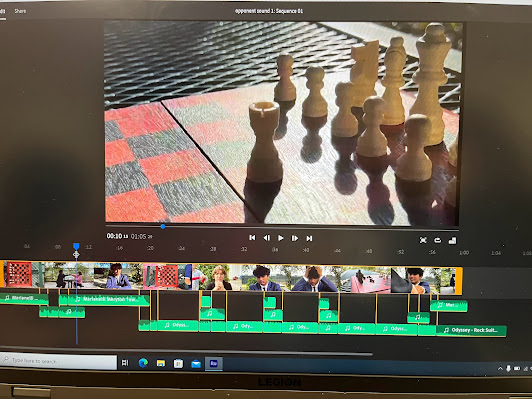How does your product engage with audiences and how would it be distributed as a real media text?
My product engages most with audiences through its narrative and associations with the comedy genre. The film has a strong, exaggerated storyline portrayed through the actors' facial expressions, as well as the mis en scene, sound, and editing decisions implemented in it. The switch from a calm, competitive game to an aggressive, comical chess war creates a comedic effect for audiences to enjoy. This plot twist is supported by straight cuts from one shot to another, displaying the contrast of each chess player’s personality and skill level throughout the film, whether it be a close-up of one player’s face reacting to the other or of their chess move in slow motion to intensify the game even more.
The film begins with light music but then switches to intense rock when the girl starts to ‘transform’ into an amazing chess player with a dramatic flair for competitiveness. These choices each have thought-out reasoning as to why they were used specifically, which in turn, allows for all components that make up the film to create expectations, laughter, and overall comprehension for the audience of what is taking place in the film.
As a real text, this film could be played at a comedy film festival, such as the Austin Comedy Film Festival, that screens independent short film comedies to reach wider audiences. A student-based beginner film like ours is a perfect candidate for this small, but respectful film screening event for its resemblance to standard comedy genre expectations and impressions.
How did your production skills develop throughout this project?
By planning to shoot and shooting to plan — a saying my filming teacher advised us to follow, my production skills developed throughout this project. In being responsible for pulling the vision we had for the film together, I learned that thinking ahead in terms of production and voicing concerns I had as they came was essential to the success of the film.
On the first production day, I felt prepared for filming, but there were gaps in communication between me and my film crew because all of us showed up that day with unique ideas for how shooting would begin. This delayed our progress in shooting scenes that would produce a deeper narrative but, was unnoticeable in the final product because as we filmed, I considered how during the editing process, there may be something missing and I wanted to avoid this possible revelation.
So, I had my editor and sound designer begin to work on what we shot each day, whether it be trimming down clips or saving audio that could later be used. This was almost an ‘assignment’ for them to do and get back to me — without this process, we would not have realized exactly how much our film was over the duration maximum of one minute by five minutes! Going forward, I was forced to revise the original storyline in a way that conveyed the same message intended, but more concisely. I also shared a collaborative agenda document for my group to view and discuss together before shooting times, which increased the cooperation and creative dynamic I had with my group from a director standpoint.
How did you integrate technologies — software, hardware, and online — in this project?
Starting with the physical aspect of technology used to produce this film, an iPhone 14 was the camera we used, in addition to putting it on a tripod to create stabilized shots that gave more of a cinematic impression. I learned that when you get the tripod and the camera mounted in a very specific way multiple scenes will be shot, it can be beneficial to record those scenes ahead of time in the same spot to maintain consistency throughout the film. The tripod gave an edge when it came to producing aerial shots of the chess board in key scenes, such as the ‘tug of war’ the players had with the chess pieces indicating the final winner; the girl. We were able to position the tripod on a table with its front legs shortened and the back extended to not have it appear in the shot itself.
On the iPhone, we filmed from the Adobe Premiere Rush software for its extended settings in focus capabilities and editing features within the same platform. The iPhone model itself is quite new, which is why it was chosen as the camera for the film, as it was the best available to us. To aid my editor and sound designer in their technique decisions, I watched tutorials online via YouTube and within the Adobe Premiere Rush software itself to understand its potential and add suggestions.
Moreover, the Apple Airdrop Bluetooth feature and YouTube Studio helped distribute the film between us and to an audience for its ability to sustain frame quality.





